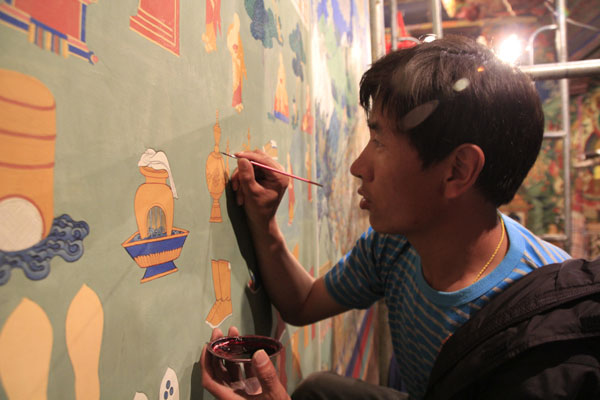 |
|
Puntsog, from Lhundrub county, and his teacher spent 18 months restoring a 12-square-meter fresco in Lhasa's Ramoche Temple. Wang Huazhong / China Daily
|
Six months' work and $244 million have restored an ancient area of the city, as Wang Huazhong and Da Qiong report.
Small shops along Barkhor Street in Lhasa had not yet opened at 6 am, but new lamps, adorned with an auspicious Tibetan knot, Buddhist symbols and scripture texts, cast a warm glow over those who had risen early to pray. The devotees moved around Jokhang Temple in a clockwise direction, chanting sutras that echoed each other.
The air smelled of night rain, local flowers, and the barley and pine branches that burned in the street.
Flower vendor Drolkar, from Doilungdeche county, said: "I grew the galsang metog flowers myself. You can offer them at the temple or take some home. I'm very grateful for the recent clearance of the drainage area. Otherwise, I'd have no place to sell my flowers. Before, the sewage flooded the street when it rained."
The old urban area of Lhasa, which sprawls from the center of Barkhor Street, has a rich traditional and religious flavor. It is home to 27 temples, including Jokhang Temple, which is a World Heritage Site, and 56 vintage courtyards.
The government has renovated 1,300-year-old Barkhor Street many times before; in 2002 alone, it spent 170 million yuan ($27.6 million) on improvements.
But the infrastructure still lagged far behind the needs of the burgeoning businesses, booming religious activities and people's lives. More than 6 million tourists flock to the Tibet autonomous region annually and the population of the 1.33-square-km old town has risen to 80,000.
Before the latest renovations, cables intertwined like cobwebs hung over Barkhor's 35 alleys. Power and water supplies were inadequate and inaccessible in many areas.
The city government started the latest renovation drive, the third in recent history, in late December, investing 1.5 billion yuan in the six-month project.
Its primary aims were: to protect the historic heritage, improve the lives of the locals, and conserve the culture, according to the feasibility study for the effort.
"The project's main priority was to improve the civil infrastructure and eliminate safety hazards, such as fire risks," the report said.
We recommend:
